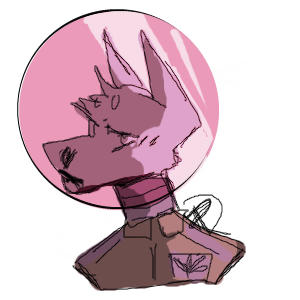Announcement wrote:We are currently looking for artists! More details
here.

What are they wrote:Ribbits are nature's strange combination of a rabbit and a frog. They normally have bright color schemes which often make them stick out.
Anatomy wrote:These odd creatures, fully grown, can be anywhere from the size of a small rabbit to a large house cat. There is no noticeable differences between males and females, which make some people question if they have a gender at all. Their front legs are quite a bit shorter than their back ones and have small paws where as the other two have toes much like a frog. One may think this would cause them to walk awkwardly, though since they hop more than anything, it works for them. Starting from their stomach thick fur grows that reaches all the way to their forehead, where it normally hangs in their eyes. Since Ribbits have very poor eyesight anyways, this isn't much of a determent. Ribbits have a voice sac under their throat, much like a frog's, but unlike these other amphibians, these creatures have multiple uses for it. They use it to croak, their way of communication, but also to carry things. This can be anything from rocks to their own children. To make sure this stays clean, they have a colorful liquid that can rid their throats of any bacteria.
Habitat wrote:Typically, Ribbits live in very damp and humid climates. Their skin needs constant moisture or they could become sick, potentially dying from this. Common areas are swamps or rain forests though it is not uncommon to find them other places. A simple lake or pond could cover this need so as long as the area is not too dry, a Ribbit could most likely be seen hanging around somewhere.
Breeding and tadpoles wrote:breeding wip
A Ribbit is born in a small egg and for the first month gets all their needed nutrients from that. Normally, the mother will hold these eggs in her throat to ensure their safety. After they get too big they emerge on their own as a small tadpole. They don't yet have legs or fur, but they do have gills and need to stay in the water. After around a month, small limbs start to form and their tail shortens. This process is much like a frog's morphing. By the time they are a year full legs and selective fur have grown and they can now walk. A good parent would keep them in their throats until they become too big, but it's not uncommon for them to be abandoned and left to survive on their own. It takes around two years for them to complete the transformation and they eventually lose their gills, along with most of their tail.






























